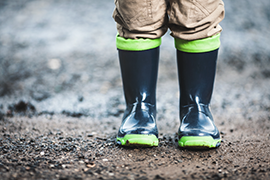
As the end of the year nears, CCAoA’s Emergency Preparedness Team has been reflecting on the disasters that struck in 2017. Top-of-mind, of course, are the hurricanes—Harvey, Irma, and Maria. Our team worked directly with CCR&Rs affected by the storms and the providers they serve. This is the second of three blogs on lessons learned and our team’s advice for CCR&Rs about the critical things they need to do before, during, and after a disaster. Here's what you can do before a disaster.
If your CCR&R is affected by a disaster, here are some critical steps to take as the disaster unfolds:
1. Follow the instructions of your local officials
- To stay on top of what they’re advising and get up-to-date information, check your local broadcast media, government social media accounts, and weather radio
- Heed their advice if they tell you to
- Stay off roads
- Stay inside
2. Be prepared for anything
- Situations evolve rapidly during disasters. What is safe one minute (sheltering in place) may quickly become unsafe (flood waters approaching your area). Understand you may have to be nimble in your response.
- Be prepared for a variety of scenarios. For example, you may have to evacuate. If so, where will you go and what will you take with you? Or, you may be told to shelter in place. Do you have the necessary supplies in your home or office to do so? Discuss these plans with your staff and family. They will need to know where you will meet them if you evacuate and where you will be in you stay put.
- Power can go out quickly. If you are able to, keep your cell phone plugged in so its batteries are fully charged in case you lose electricity.
- Likewise, fill a large bucket or tub with fresh water so you and others in your office have plenty to drink.
- If you are outside and see any downed wires, treat them as LIVE wires
3. Remain calm
- The situation will be stressful, but there are things you can do to help calm yourself. You know yourself best. Which of these would be most helpful to you: taking deep breaths, stretching, playing a board game, drawing, something else?
- Keep yourself and others around you occupied; it will lower anxiety levels and make the time pass faster.
4. Keep in contact with family, friends, coworkers, and providers you serve
- Throughout the disaster, keep in touch with your contacts. Find out where they are, if they are safe, and what the situation is wherever they’re located. You may be able to share information with them as well (e.g., power outages, evacuation plans, locations of shelters, etc.).
- Consider designating an out-of-town contact to help you coordinate your actions/plans. Someone outside your affected area will likely have power and other resources which you may be missing. That person can help relay messages between you and others and provide you with a fuller picture of the situation as a whole.
- You may want to start a group text message chain. Due to their small bandwidth and size, text messages often can be sent when even when cellular phone calls cannot.
- Use social media to share your status. Platforms like Facebook offer “safety check” and Red Cross “Safe and Well” buttons, which allow you to easily and quickly communicate that you are okay.
5. Plan your next steps
- Once the disaster is over, you will have many things to do. If you can, take time during the disaster to think about and prioritize your next steps.
- And/or, take the time to locate important documents and phone numbers that will allow you to begin to recover quickly (e.g., contact information for your insurance company, landlord, etc.).






